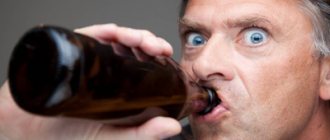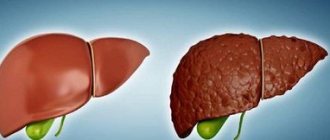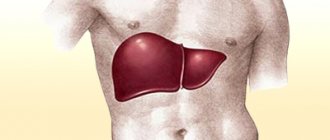The condition of the liver largely determines the condition of other organs and systems.
At the same time, the liver, due to its functional load, is susceptible to a number of diseases. Everyone knows about diseases such as hepatitis or cirrhosis. However, not everyone knows about the deposition of calcium salts in liver tissues. This article will talk about calcifications in the liver, as well as what contributes to their occurrence and what preventive measures are the most effective.
Indications for liver ultrasound
The doctor may refer you for an ultrasound examination of the liver if the patient’s tests are poor. In addition, ultrasound is prescribed to clarify the diagnosis, since many diseases have similar symptoms, but are treated differently.
Reasons for undergoing ultrasound diagnostics of the liver:
- Pain in the right hypochondrium - a feeling of discomfort can occur after physical activity, eating fried and fatty foods, alcohol, etc.
- Changes in skin color, as well as mucous membranes - yellow-gray and yellowish tints of the skin indicate liver dysfunction.
- Abuse of alcohol, drugs or other drugs.
- Suspicion of an abscess.
- Gynecological diseases.
- Pancreatic diseases.
- Previous chronic liver diseases, as well as hepatitis.
Ultrasound is also prescribed to monitor the patient’s condition during the treatment of many serious illnesses. It is advisable to check the liver for pathologies before choosing hormonal contraceptives for women.
Doctors in this field
Signs of liver calcification
The disorder does not always occur with clinical manifestations. In most cases, patients learn about the pathology only when contacting them for another issue or after a planned examination.
Calcinosis is not an independent disease, therefore it has no specific symptoms. Pathology is detected using objective research methods. A violation can be assumed based on the clinical picture that occurs during inflammatory processes in the liver.
If there are a lot of calcifications in the liver, they can cause the following symptoms:
- nausea, vomiting;
- decreased appetite;
- painful sensations in the right hypochondrium;
- yellowness of the skin;
- stool disorder;
- decreased performance, emotional lability.
Nutrition for a diseased liver
When the gland is parasitic, symptoms of intoxication and allergic reactions occur, and hepatosplenomegaly (enlarged liver and spleen) is characteristic.
With echinococcosis of the liver, a round, dense formation (cyst) can be felt. The patient sleeps poorly, often experiences headaches, acne and rashes appear on the skin, and there is an unpleasant odor from the mouth.
If calcification develops against the background of tuberculosis, then the patient quickly loses weight, feels constant weakness, pain in the right hypochondrium, a dry cough first appears, and then sputum with blood clots comes out. The liver and spleen are significantly increased in size.
What is examined during an ultrasound of the liver
When examining the liver using ultrasound waves, the general condition of the organ is assessed: the obtained parameters are compared with standard indicators, they check whether there is inflammation, and also examine the vessels and bile ducts.
Homogeneous structure, smooth edges, bile duct up to 0.8 cm, portal vein diameter about 1.3 cm, left lobe size no more than 7 cm, right lobe within 12-13 cm - this is how a healthy human liver looks on an ultrasound. Deviations in indicators indicate the development of pathologies.
Diseases that can be detected by ultrasound examination:
Liver calcification is a compaction impregnated with layers of calcium. Catalysts for the development of the disease are past infectious diseases (amoebiasis, malaria, tuberculosis, etc.).
A cyst is a cavity neoplasm containing fluid inside. Cysts can be single or multiple. In congenital polycystic disease, neoplasms occupy up to 60% of the organ tissue.
Cancer is a malignant formation, has a heterogeneous structure and blurred edges. They check it with Doppler ultrasound; the disease may look like a combination of several areas of different echogenicity.
Hemangioma is usually localized near vascular structures, the boundaries of the neoplasm are clear, and there is an acoustic track. The diagnosis requires confirmation by computed tomography.
Also, ultrasound examination can reveal diffuse changes - modifications of the parenchyma due to dystrophy, hypertrophy, swelling, fibrosis. Such symptoms can occur with sclerosing cholangitis, cirrhosis, autonomic hepatitis and other liver diseases.
Diagnosis of the disease
In most cases, liver calcifications are discovered by chance during examination of the organs where they were deposited. As practice shows, calcifications can remain in the tissues of the liver or other organ for many years, resulting from trauma, helminthic infestation, inflammation or necrotization. The easiest way to detect calcium salt plaques is with magnetic resonance imaging (MRI). This diagnostic method allows you to obtain the highest quality three-dimensional visualization, although due to its high cost it is used infrequently.
Calcifications in the liver can also be diagnosed by X-ray examination. They can be seen as rock-like formations in the image because they have the same consistency as bone.
Ultrasound is considered less effective than the previous two methods, but can also be used to identify areas of calcium deposits in liver tissue.
A biochemical blood test can determine an increase in calcium levels, but this method is auxiliary against the background of X-ray examination and magnetic resonance imaging.
Preparation for the procedure
In order to properly prepare for an ultrasound of the liver, the patient must get rid of increased gas formation in the intestines, otherwise the liver will be poorly visible on the ultrasound.
Meals during the preparatory 3-4 days should be fractional (at least 4 times a day), small portions of food should be consumed. You will have to temporarily exclude fatty meat, dairy, legumes, and foods containing yeast from your diet. You can only drink still water - about 1.5 liters per day.
Immediately before an ultrasound scan of the liver, you should not eat or drink; the examination should be carried out on an empty stomach; the morning hours are optimal for these purposes. People suffering from bloating, constipation and difficult digestion need to take medication: take enterosorbents (activated carbon, Polysorb and others), enzymes, laxatives, and drink herbal teas.
Treatment of liver calcification
When treating calcifications, it is necessary to understand that they are only a consequence of another disease. That is why treatment will be based on eliminating the root cause, that is, the underlying disease.
For example, if calcification is caused by hepatitis, you must first undergo a course of treatment with antiviral, immunomodulating drugs, as well as hepatoprotectors, and only after that begin to eliminate the consequence - that is, calcifications.
Intravenous drip injections of Ringer's solution, glucose or rheosorbilact are prescribed. If the kidneys are affected along with the liver, hemodialysis is advisable. Surgical removal of areas of calcium salt deposits is not advisable, since it does not affect the root cause, and the inevitable trauma to healthy tissue adjacent to the calcifications can lead to even more serious consequences. There are cases when calcifications are simply old artifacts from a long-term disease, therefore, in the absence of complaints, special treatment is not required.
To prevent the deposition of calcium salts in the liver, care must be taken to prevent liver diseases. It is recommended to consume low-fat and moderately spicy foods, fruits and vegetables, buckwheat, wheat and oatmeal. Preference is given to boiled and baked dishes (can be cooked in an air fryer or steamed). Alcohol is allowed only in moderation (for example, a glass of wine once a week), otherwise there is a risk that when treating liver diseases you will have to give it up altogether. It is recommended to drink as much purified water as possible to remove harmful substances from the body.
A good prevention of parasitic infestations is the consumption of pumpkin seeds. Meat (especially pork and river fish) must be thoroughly fried.
Prices for liver ultrasound*
You can find out the cost of liver ultrasound in Moscow, as well as make an appointment by phone or leave a request on the website.
| NAME | PRICE (Kolomenskaya) | PRICE (Vidnoe) |
| Ultrasound examination of the liver (using Voluson, Mindray, Logiq) | 1400 rubles | 1400 rubles |
| Duplex scanning of liver vessels (using Voluson, Mindray, Logiq) | 2500 rubles | 2500 rubles |
We accept payment:
*Attention! The indicated prices are provided as reference information and do not constitute a public offer. Check current prices by phone and directly in clinics.
Diagnostic measures
Since there are no nerve endings in the liver, calcifications in organs are almost always discovered by accident: for example, during an ultrasound examination in connection with problems in other organs or during a routine examination. It may be that these calcifications formed in childhood, and they were only discovered now. In some cases, patients learn that the liver is affected by calcifications only when the disease is already in an advanced state.
The following types of studies can be used to detect calcifications:
- Radiography. Mineral accumulations are clearly visible in the image, as they have a higher density than liver tissue.
- This method can detect fairly large formations.
- Computed tomography or magnetic resonance imaging. They help determine the exact location and size of calcifications.
Along with an instrumental examination, the attending physician may refer the patient for blood tests for calcium and phosphorus levels.
There is little point in preventive diagnostics if there are no complaints and risk factors. That is, if nothing hurts you, and there are no scientifically proven prerequisites for you to develop calcifications, there is no need to run to the doctors and get checked.
Prevention
Preventive measures include maintaining a healthy lifestyle and completely giving up bad habits.
As for proper nutrition, a person needs to consume as much parsley, dill, fresh fruits, vegetables, lean meat, and all kinds of dairy products during the season of fresh vegetables and fruits. For sweets you can eat honey, nuts, dried fruits.
It is very important to drink plenty of clean water and always do physical activity on the body, spend as much time as possible in the fresh air.
Be sure to monitor your health; if anything bothers you, seek help from a specialist.
Treatment with traditional methods:
- Dry pumpkin seeds will help you against helminths,
- eat fresh pumpkin with honey,
- drink herbal teas made from milk thistle.
Remember that treatment with traditional recipes must be agreed with your doctor, because in some cases it is necessary to take medications.
How to treat?
To minimize the harmful effects of calcifications on the liver, you should understand what it is: prescribing treatment after a correct diagnosis is not difficult. These formations are always secondary and can only be overcome by overcoming the underlying disease.
Is there a drug treatment?
The treatment regimen depends on what pathology caused the formation of calcifications. For example, for hepatitis it includes:
- antiviral drugs;
- immunomodulatory agents;
- hepatoprotectors.
The fight against calcifications includes drip administration of solutions of glucose, Ringer, rheosorbilact. If there are foci of lime deposits on the kidneys, hemodialysis is prescribed.
Surgical removal of calcifications in most cases is not practiced due to the fact that the harm caused to surrounding healthy tissues outweighs the benefits of such surgical intervention.
After treatment, you will have to adhere to certain dietary restrictions for the rest of your life:
- When cooking, minimize the use of fats;
- reduce consumption of table salt, fried, spicy and fatty foods;
- take protein in the form of fish dishes and fermented milk products;
- eat more seasonal homemade fruits, herbs, and vegetables;
- drinking - up to 2 liters per day, provided the kidneys are healthy;
- only natural sweets - dried fruits, honey;
- giving up alcohol and tobacco.
Answering the question about what calcification of the left or right lobe of the liver is for the human body, an experienced doctor will call such a pathology a marker of the presence of serious problems in the body. Whether they are a thing of the past or still threaten human health will be revealed by a more thorough examination.
It is necessary to adhere to a healthy diet
Folk remedies
The advice of healers comes down to three main points:
- eat more pumpkin seeds and pulp to expel worms from the body;
- drink plenty of clean water to remove toxins and excess salts;
- eat well-cooked fish and meat in order to destroy parasites in them.
Since treatment with folk remedies is always a complex undertaking, it is recommended to use turmeric and milk thistle to maintain the overall performance of the liver.
Prevention
To prevent the formation of calcifications in the liver, first of all, you need to pay attention to your diet. It is recommended to minimize the consumption of fatty, fried, spicy foods, baked goods, sweets, and salt. Coffee and alcohol-containing drinks are prohibited. You need to eat more:
- fruit;
- vegetables;
- greenery;
- dietary meat;
- seafood.
Eating honey, raisins, nuts, and dates will be beneficial. Dishes must be steamed, boiled or baked.
Particular attention should be paid to the drinking regime - the daily water intake should be at least two liters. Compliance with this condition will help remove toxic substances and waste from the body that cause liver diseases.
Alternative medicine methods also have a positive effect on the functioning of the liver; they improve its functional ability and also eliminate pain. For example, pumpkin seeds help prevent infection by parasites, resulting in a reduced risk of calcifications. Infusions of medicinal herbs (milk thistle) in combination with honey improve the function and condition of the liver. Such measures can be used as adjuvant therapy.
Diagnosis of calcifications in the gland
At an early stage, it is almost impossible to suspect calcifications in the liver in an adult or child, taking into account the symptomatic picture. When the patient is not worried about anything, it means he does not see a doctor.
If characteristic signs are present, a number of studies are prescribed - CBC, blood biochemistry, urine test (general, according to Nechiporenko). Additionally, you need to donate blood to determine the concentration of endocrine hormones. Instrumental diagnostics – ultrasound, CT and X-ray.
Using ultrasound, the number of salt tumors, their type, and size are determined. You can also evaluate the condition of the liver, the degree of damage to the parenchyma (it is damaged against the background of large and hard calcifications).
Calcinosis in the fetus, newborn child
After 20 weeks of pregnancy, subcapsular hyperechoic formations in the liver up to 0.3 mm in size can be detected in the fetus. This is calcification, the cause of which is acute inflammation occurring in the peritoneum of the fetus. The presence of calcifications is determined both during intrauterine development and in newborns.
Deposits most often appear in the right lobe of the liver and spleen of the child. Isolated calcifications, even in the plural, do not pose a serious danger to the baby.
Only microcalcifications are dangerous - they form against the background of meconium peritonitis. They negatively affect metabolic processes and the immune system. Children are born prematurely and underweight.
If calcifications were detected in the fetus, this will not mean that the mother requires urgent treatment. Therapy begins only after birth if there are medical indications.
Folk remedies
Treatment of calcinosis is carried out using traditional recipes. If mineral accumulations appear as a result of helminthic infestations, then pumpkin is used to prevent them. For this, the patient should consume a couple of handfuls of pumpkin seeds every day.
Pumpkin seeds are used to prevent helminthiasis, which provokes the formation of calcifications
Pumpkin pulp is used to normalize the functioning of the liver and other hepatobiliary organs. In this case, the fruit is baked in the oven with honey.
Herbal decoctions based on milk thistle have a beneficial effect on the condition of the liver. By drinking such a drink, the patient can remove small calcifications from the gland.
Before using folk remedies, you should consult a doctor. Such recipes are used only as part of complex therapy.
What is calcinosis?
Let's look at what calcifications are. Areas of liver tissue have different sizes, calcium salts are deposited in them, neoplasms are called calcifications, and the disease itself is calcification. Formations can form in other internal organs - prostate gland, spleen, lungs.
The disease manifests itself as a result of infectious processes, malignant or benign tumors, and parasitic diseases. Pathological deposits appear due to mechanical stress - trauma.
The exact causes of development are unknown, but the factors have been fully studied. Doctors believe that salt deposition occurs due to metabolic disorders. There is an alternative theory, according to which the human body itself directs salts to the damaged area of the organ to stop the destruction.
Calcium salts can be in the right and left lobes of the liver, or in their areas, in blood vessels, bile ducts. Hard lumps consisting of salt deposits replace hepatocytes. How many can there be? A few or a lot. Of particular danger are multiple formations localized in the main bile duct.
Causes and factors
Liver calcification is not an independent disease. It occurs after various diseases, so salt deposits are a kind of protective reaction of the body in response to prolonged inflammation.
Causes and development factors:
- Disturbance of metabolic processes.
- Parasitic diseases (ascariasis, opisthorchiasis, echinococcosis, alveococcosis, etc.).
- Inflammation of the liver caused by various causes.
- Hepatitis of viral origin, acute or chronic.
- Long-term use of medications to treat viral hepatitis.
- Complications of tuberculous liver disease.
The body reacts to pathology by forming calcifications - it “seals the problem area so that it does not spread to healthy tissue.”










